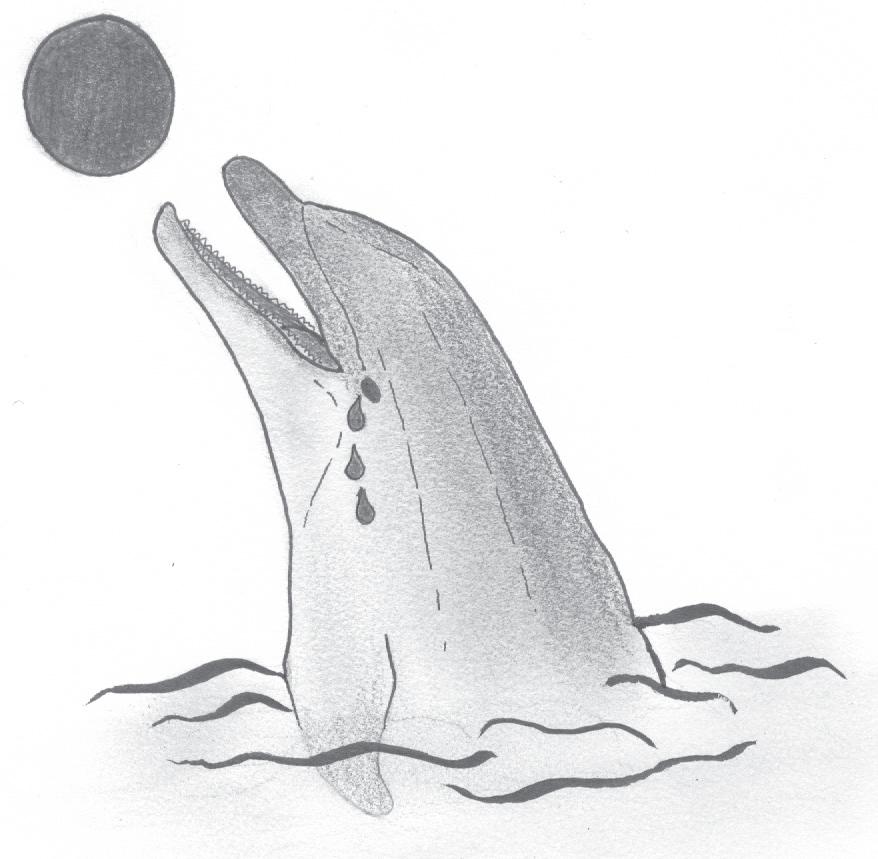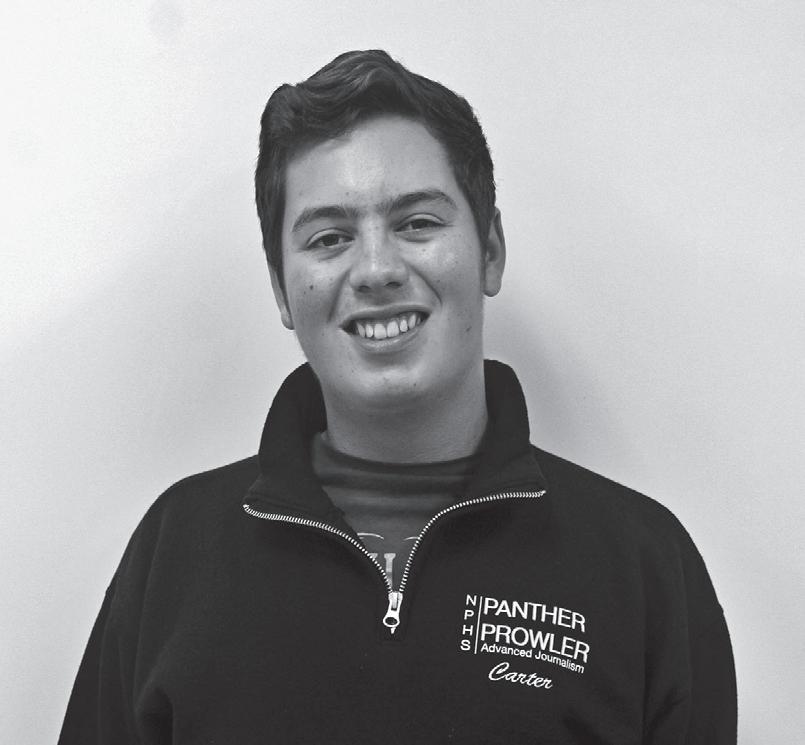
14 minute read
Dolphins
Emma Schoors
News Editorews Editor
Advertisement
“Just because it feels good, it doesn’t make it right,” wrote environmental philanthropist Shari Sant Plummer aft er playing with bottlenose dolphins at the National Aquarium--dolphins that had been born in captivity and do frequent shows for onlookers like her to marvel at. Th e famously smiley animals hop along the glistening waters of their tanks and do endless tricks. Th ey squint in joy when being pet by audiences, like they are superstars on the red carpet with the spotlight shining brightly down on them. However, there are more than a couple things wrong with romanticising the captivity of dolphins and other animals this way. Th e high chlorine levels in the water can damage a dolphin’s eyesight, urging them to fl oat near the surface where there

are less chemicals and less pain. Th ey squint to lessen the burning. Th ey are constantly being pet and exposed to the hot sun, and their skin can develop rashes and bruises that need to be treated with various creams and ointments. In the wild, dolphins live on fresh fi sh that they catch themselves, but in captivity, they have to be trained to feed on dead, frozen fi sh. Beyond their unideal eating situation, they’re kept hungry before their performances (a tactic called ‘food deprivation training’) t o ensure t h e best results for their audiences, which means that doing tricks is oft en the only way these animals will be fed. According to science.org the average dolphin lifespan is anywhere from 40- 50 years, but for a captive dolphin this number can be cut in half. No tank can properly replicate the kinds of predators and threats they deal with in the wild, so dolphins born in captivity are highly unlikely to survive if they are ever released into their natural habitat. Visiting dolphins in their natural habitats can be an educating and fun experience, and you can actually take a peek into how these animals make their way in their world naturally. Grabbing a bag of popcorn and watching a dolphin show might seem like a harmless feat, but the unnatural stress and extensive physical damage it does to these animals is just not worth the trip.
Emily Augustine/Prowler
Emma Schoors
News Editorews Editor
As long as a zest for long baths in ice cold Atlantic water is not a boarding requirement, Titanic II is a genius idea that should be given a chance by possible investors and passengers alike. Th ere are a couple of things that come to mind when the average person thinks of Titanic. Young Leonardo DiCaprio, a piece of wood that could have fi t him if he dared to try and the real sinking of the RMS Titanic that killed 1,500 people on a freezing April night in 1912. Now it is sitting two miles down at the bottom of the ocean with bacteria eating and disintegrating it rapidly, and billionaire Clive Palmer is dishing out a heft y $500 million to do it again, this time with the help of navigation, radars, plenty of lifeboats, and a brand new diesel engine. Th e bridge of the ship will be one

of the only rooms that will be completely diff erent than the original. Th e replica will include many of the original’s selling points; the lavish staircase, luxurious restaurants, a heated pool and even a gym with state of the art workout equipment- by 1912 standards anyway. Each of the dining and living rooms will be replicated, and guests will reportedly be treated to era clothing pieces to further the early 1900’s experience.
Best case scenario, the complementary iceberg collision and eventual sinking of the ship will not be an inclusion. With luxury comes expense, and Titanic II is no exception. Complete with the option of

fi rst, second, and third-class guest rooms, passengers are looking at a pretty penny for the do-over. In today’s standards, a thirdclass ticket on the original Titanic could cost anywhere from $350 to $900, and if you were a wealthy or infl uential fi gure, a fi rst-class ticket could do the damage of $1,700 to $50,000. One can only imagine what the tickets for the improved trip will cost. Titanic II is set to sail as early as 2022, with her maiden voyage venturing from Southampton to New York; a trip on which her predecessor sunk aft er a collision with an iceberg over a century ago. Th e original ship had intense pressure to be built quickly and break records at the time. With the lack of rush and much better materials available to complete the voyage safely, anyone with the means and interest to should consider sailing on this iconic, upgraded ship when the time comes.
Athiests havethiests have feelings tooeelings too

Carter Castillo
Opinion Editorpinion Editor


Atheists have no sense of morality and their main goal in life is to indoctrinate good religious children, or at least that’s what some people in this community want me to believe. Th ere has been a lot of anger from the religious right about California’s new sexual education policies, which has caused many of them to use religion as a motive for their opposition. In the heated conversations between community members, there is at least one thing they all seem to agree upon, that nobody wants to discriminate against anybody based on their religion.
Even though community members and politicians claim they do not want to discriminate based on religion, when you look at their rhetoric it is clear that discriminating is exactly what people like her are doing. When a member of a public school board gets in front of large groups of people and warns them about a secular humanist curriculum she is only feeding into the hurtful stigma that atheists deal with.
Humanity has always had some form of religious identity, and trust me, I have heard that “everybody needs to believe in something,” but maybe I just don’t, and I don’t think that makes me any less of a person than my peers. Th ere seems to be this idea that because atheists don’t believe in god, that inherently makes them incapable of interpreting morality.
I say this not out of a place of anger, but out of hurt. I’m tired of having my religious beliefs (or lack thereof ) as being used as a false conspiracy for far-right religious leaders to oppose more inclusive curriculums in school. Most atheists don’t fi t the stereotype of a smug late night TV host who constantly has an aura of superiority, they are humans like the rest of us. Just like all humans, atheists want to fi t in, make friends, and get along with people.
My opportunity to decide who I am and what my religious or spiritual beliefs are should not be infringed upon by people who may have contrary ideas. I am so tired of the feeling of not being included, because when people say we accept “all religions” it always feels like the caveat is that they only seem to want to accept those with a religion.
I’m not naive, I know a lot of people will be angry or resort to gross personal attacks, and I certainly know that no matter what I say some people will shut themselves off and resort to their intolerance, but I hope that my message resonates with those who have open minds. I want to respect people’s views that are so diff erent than mine, but I struggle to listen when they are preaching intolerance of me.
Manas Khatore

Entertainment Editorntertainment Editor
Th e Sandy Hook Promise (SHP) has been making an impact on schools across the nation. Named aft er the 2012 elementary school shooting, the organization aims to prevent gun violence in schools by discussing social issues that aff ect today’s students. Over the past month, SHP has been visiting CVUSD schools, giving an assembly at NPHS on Sept. 26. Since assemblies are their main tactic for reaching students, I expected it to reach the high caliber of SHP’s goal. Unfortunately, the assembly fell short, undermining the purpose of SHP as an organization.
Th e program was titled “Start with Hello” and focused on inclusivity and creating a connected student body. While all of this is important, there was no mention of gun violence. Th e majority of the presentation was focused on reaching out to outcast students, but the connection between this and school shootings was not clearly established. It seemed as though SHP is assuming that lonely students are the cause of all violence in schools.
Even if this was their intention, a school assembly is not the perfect medium for getting the message out. If students are excited about an assembly, it’s most likely because their class time is considerably reduced. Unfortunately, many students used the assembly as a free period, as seen by the number of people talking to their peers or on their phones instead of giving the speaker respect.
In addition to giving assemblies on positive school cultures, SHP should be encouraging students to become involved in their local and national governments. Providing resources for voter registration and hosting community forums discussing gun violence inspires passionate students to use their voices for change. As seen by the March for Our Lives protest, student-led movements are powerful and can have an impact on lawmakers, much more so than loosely focused school assemblies that places the responsibility of preventing gun violence on students and solely inclusivity.
SHP describes itself as a “moderate, above-the-politics organization” trying to address the gun violence epidemic in America. But in order to eff ectively do this, SHP needs to be directly involved in politics. Th e organization needs to devote more of its time to advocating for tangible solutions to gun violence

Lifeguard on Duty- Brandon Rainey, Sandy Hook Promise West Regional Training Manager, spoke to students about reaching out to their peers who may be isolated. “If not me, then who, if not now, then when, I’m using my swag, my creativity, my intellect, and my infl uence, to be a lifeguard on duty,” Rainey said. According to Rainey, every student brings intellect, creativity, swag and infl uence to the table. He invited seven students to participate in an activity to emphasize openness on campus.
Prasheetha Karthikeyan
Features Editoreatures Editor
In a world where people need to be held accountable for their actions, where racism, homophobia, and all around bigotry have no place, Urban Outfi tters, with their ridiculous business model and continuous scandals, simply does not make the cut, and no one is talking about it.
Urban Outfi tters (UO) has been provoking controversy for years, its most notable scandal being in September 2014, the selling of a “vintage” faux blood stained Kent State sweatshirt, directly referencing the Kent State massacre of 1970. Referencing a horrifi c mass shooting like this is deeply disturbing and disgusting.
Th e company also has a history of making products incredibly off ensive to just about every ethnicity. In April 2012, UO was sold shirts reminiscent of what Jews wore during the Holocaust, only pulling it aft er understandably angry statements from several sources. Th e shirt’s designer’s response was simply that the shirt was not meant to be for sale, which begs the question: why was it even designed to begin with? Th ree years later, UO released a gray striped tapestry with pink triangles, alluding to what gay men

wore in concentration camps. Other ethnic groups that have been attacked by UO’s products include Irish-Americans, AfricanAmericans,Native Americans, IndianA m e r i c a n s and MexicanAmericans.
U r b a n Outfi tters also has a history of r o m a n t i c i z i n g mental illness and addiction. In 2010, aft er major backlash from eating disorder activists, UO was forced to remove a shirt with the words “Eat Less.” In 2016, both a “Shampoo for Suicidal Hair” and a crop top covered with the word “depression,”both of which were later pulled in 2016, turned the dangerous mental illness into a trendy fashion statement . A line of prescription bottle themed items romanticizing prescription drug abuse, such as glasses and fl asks, was pulled in 2013. Eat
Less Emily Augustine/Prowler
Th e worst part of this is that whenever UO is caught in the act, they seldom issue an apology.When they do, it’s usually the “sorry, not sorry” type. Th is conduct is severely overlooked by this generation, primarily because UO’s target audience is the privileged white teens who are ignorant to prejudice because it doesn’t aff ect them or they only care about the “aesthetic appeal” of the brand.
Many articles suggest that the cause of UO’s recurring immoral behavior is a PR strategy to make the company look edgy because, obviously, being racist is the new quirky. Other articles attribute it to pure negligence. However, aft er the outrageous number of run-ins UO has had, it’s fair to conclude that such incidents are not accidental.
In a way, it is the perfect plan. With privileged consumers buying products for the brand uner the impression that it’s fun and trendy, they are promoting this bigoted agenda, unknownst to themselves. We should be holding UO accountable and boycotting them for this behavior.
Emily Augustine Emily Augustine

Front Cover EditorFront Cover Editor
Th e city is a fast moving place. Most of the people who inhabit the city all have a place to be and pressing tasks to accomplish, but one group of people stands still: the homeless.
According to the Los Angeles Homeless Services Authority, over 36,000 people in the city of Los Angeles are homeless as of 2019. Th is is a whole community of people whose voices are silenced by the media just because it makes people uncomfortable to see how they live.
How many fi lms can you name that are devoted to those in America who are living without a home? Th e closest form of media I can recall is one I learned in a history class. Jacob Riis published “How the Other Half Lives” in 1890, a photojournalistic piece that captures how people lived in New York’s slums.
Th ese fi lms about homelessness do exist, but they are not well known. For example, “Lost Angels : Skid Row is my Home” is a 2010 documentary following eight homeless people living in Los Angeles. “Los Angeles’ Skid Row is home to one of the largest homeless populations in the United States” according to an organization known as Haven Toronto.
I have been a witness to homelessness in every major city I have visited, including Los Angeles. I have seen homeless people talk gibberish to themselves, scream in the middle of the street and pretend to be a bush only to startle people who walk by.
It is clear to see that a signifi cant portion of these people are mentally disabled. As I watch them suff er all alone, I imagine what there life must have been like. Have they always been like this? Did they have the support they needed growing up? Who abandoned them?
However, I have also seen homeless people who do not have severe mental disabilities. I can tell by the way they mope when they sit on the side of the street with the cardboard sign pleading for fi nancial help. Th ey are aware of the situation they are in.
Mentally disabled or not, these people need our recognition. Th e media should know the importance of preventing homelessness considering the center of the fi lm industry is surrounded by thousands of homeless people.
On an individual level, the homeless need our support, or our kindness at least. Mental illness is not a laughing matter, especially when it comes to those who have been left with nothing. Respect them by not joking about their suff ering. If you ever walk by a

Emily Augustine/Prowler








